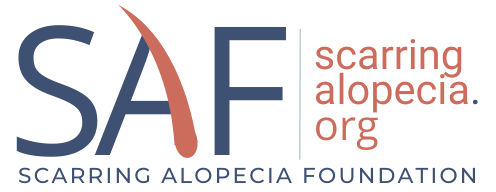Medical Treatment Options for Hair Loss: Differences and Similarities in Common Medications Used for Cicatricial (Scarring) Alopecia
Jennifer A. Wintringham
Cicatricial (scarring) hair loss has a variety of different treatment options which can be overwhelming to patients. In general, all these medications are used to reduce or halt the progression of hair loss, control associated symptoms (itching, burning, pain), and reduce ongoing inflammation.1 Your specific type of hair loss will help guide the choice of medications and the duration of treatment.
Potent topical corticosteroids (i.e., clobetasol, fluocinonide) and tacrolimus, a non-steroidal topical anti-inflammatory medication, are often used as first line therapies for scarring alopecia. Both medications can help control underlying inflammation and relieve associated itching and burning. A variety of formulations including solution, foam, ointment, and gel are available for ease of application and patient preference.1 Side effects with steroid medications include atrophy (thinning) of the skin with prolonged use.
Spironolactone is an oral medication that is FDA approved as a blood pressure medication. Due to its anti-androgen effects, it is commonly used “off label” to treat hair loss. The best effects have been seen in more advanced stages of some types of hair loss and when used for long periods of time (over 1 year).2 Side effects include headache, menstrual irregularities, decreased sexual desire, dizziness, and high blood levels of potassium.
Doxycycline and minocycline are members of the tetracycline family of antibiotics. Although often used to fight infections, they are widely used in scarring hair loss for their anti-inflammatory effects.3 Common side effects may include gastrointestinal distress and increased susceptibility to sunburn. These should not be used if you are pregnant or planning to become pregnant.
Hydroxychloroquine (also known by the brand name Plaquenil) is an oral immunomodulatory medication frequently used in the treatment of a variety of autoimmune diseases. Scarring hair loss conditions such as lichen planopilaris (LPP), frontal fibrosing alopecia (FFA), and discoid lupus have shown good response to this medication.4 Before starting, a baseline eye exam should be obtained. Hydroxychloroquine is well tolerated with occasional gastrointestinal distress.5
Finasteride and dusasteride are oral medications called 5- α reductase inhibitors that block the production of male hormones. There are commonly used in male and female pattern hair loss. In cicatricial alopecia, the best evidence for using these medicines is in post-menopausal women with frontal fibrosing alopecia.6,7
Naltrexone is an opioid receptor blocker that is used at high doses to treat disorders of addiction. However, low dose naltrexone (LDN), typically between 1 to 5 mg per day, has anti-inflammatory properties may aid in some dermatologic conditions.8 LDN is especially beneficial in treating scalp pain associated with scarring hair loss. Some patients with LPP have also experienced decreased scalp inflammation and slowed progression of their hair loss.9 It has a minimal side-effect profile, especially when compared to other systemic anti-inflammatory agents.10
Nulastin is an over-the-counter hair regrowth product that is not FDA approved. It uses a special form of elastin, a protein found in skin, as the main active ingredient to support the hair follicles.11 There are no large research studies to support significant benefits to using Nulastin products, although some patients report increased eyelash and eyebrow growth.
Remember, each hair loss journey is unique and there is no one magic treatment for alopecia! Speak with your dermatologist to discuss the risks and benefits of these medications and determine which treatment is best for you.
References
- Bolduc, C., Sperling, L. C., & Shapiro, J. (2016). Primary cicatricial alopecia. J Am Acad Dermatol. 2016;75(6), 1081–1092.doi:10.1016/j.jaad.2014.09.058
- Burns LJ, De Souza B, Flynn E, Hagigeorges D, Senna MM. Spironolactone for treatment of female pattern hair loss. J Am Acad Dermatol. 2020;83(1):276-278. doi: 10.1016/j.jaad.2020.03.087. Epub 2020 Apr 5. PMID: 32259535.
- Fu JM, Price VH. Approach to hair loss in women of color. Semin Cutan Med Surg. 2009;28(2):109-114. doi:10.1016/j.sder.2009.04.004
- Chiang C, Sah D, Cho BK, Ochoa BE, Price VH. Hydroxychloroquine and lichen planopilaris: Efficacy and introduction of Lichen Planopilaris activity Index scoring system. J Am Acad Dermatol. 2010;62(3):387-392. doi:10.1016/j.jaad.2009.08.054
- Price VH. The medical treatment of cicatricial alopecia. Semin Cutan Med Surg. 2006;25(1):56-59. doi:10.1016/j.sder.2006.01.008
- Tosti A, Piraccini BM, Iorizzo M, Misciali C. Frontal fibrosing alopecia in postmenopausal women. J Am Acad Dermatol. 2005;52(1):55-60. doi:10.1016/j.jaad.2004.05.014
- Camacho-Martínez FM. Hair loss in women. Semin Cutan Med Surg. 2009 Mar;28(1):19-32. doi: 10.1016/j.sder.2009.01.001. PMID: 19341939.
- Shabeeb N. The lowdown on low-dose naltrexone. Cutis. 2020 Jan;105(1):E17-E18. PMID: 32074159.
- Strazzulla LC, Avila L, Lo Sicco K, Shapiro J. Novel treatment using low-dose naltrexone for lichen planopilaris. J Drugs Dermatol. 2017; 16: 1140-1142.
- Lee B, Elston DM. The uses of naltrexone in dermatologic conditions. J Am Acad Dermatol. 2019;80(6):1746-1752. doi:10.1016/j.jaad.2018.12.031
- Ensley B. Hair Vitality Loss and Thinning: Benefits of Elastaplex™ Technology. NULASTIN INC. https://nulastin.com/pages/science. Accessed August 13, 2021.
